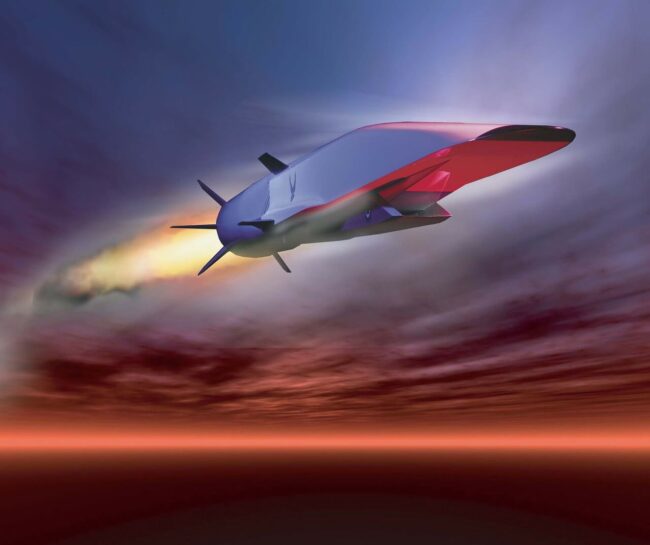Hypersonic weapons Hypersonic weapons travel at least five times faster than the speed of sound. Five times The speed of sound is roughly 4000 miles
Hypersonic weapons
Hypersonic weapons travel at least five times faster than the speed of sound. Five times The speed of sound is roughly 4000 miles per hour at that speed, The Hypersonic weapon could travel between New York and Beijing, and about 1 hour and 40 minutes. Some weapons could travel even faster up to about 20 times the speed of sound Sonic missiles in nothing new China, Russia, and the United States have had them for years.
In fact, ballistic missiles travel at Hypersonic speeds, But ordinary ballistic missiles are on a set trajectory after their Rocket motors burn out like a dart after release. They cannot change course. What’s different with the new crop of hypersonic Weapons isn’t speed by itself. It’s the combination of speed and maneuverability over long ranges,
How to Hypersonic weapons work.
There are three basic types of guided ballistic missiles, boost Glide missiles, and Hypersonic cruise missiles. Guided ballistic missiles are like normal ballistic missiles. But the re-entry vehicle, which carries the Warhead back into the atmosphere after the missile shoots up through it as steering thins attached to guide it to the Target boost Glide weapons are propelled to Great speeds by Rockets, just like ballistic. But rather than arcing high above the atmosphere is ballistic missiles.
Do colliders re-enter the atmosphere? Shortly after launch, They rely on an aerodynamic lift to stay aloft potentially for thousands of miles Without the use of an engine. The basic idea is the same as a hang glider. Hypersonic cruise missiles are powered throughout their flight to keep flying at such Great speeds over long distances. They need special scramjet engines. The speed of the missiles itself forces air into the engine where it combusts at supersonic speeds.

Hypersonic Missile Country List
Hypersonic cruise missiles are still in the works. China, Russia, and the United States are all conducting Research into them, But only one country, Russia appears to be close to deploying one Zircon, which reportedly has a short range of about 300 miles. However, guided ballistic missiles and boost Glide missiles
Fastest Hypersonic Missile
Have now been deployed, while new types appear to be close to deployment. Who has what? Let’s look at Russia first. Russia’s Vanguard is a long-range boost Guided missile. Its glider likely re-enters the atmosphere at around 20 times The speed of sound and is designed to deliver nuclear warheads against the United States.
Russia also has many ballistic missiles that can do this Kins. All is a guided ballistic missile launched from an aircraft. It probably travels at less than half the speed of a Vanguard and has a reported range of around 1200 miles. Russian President Vladimir Putin has stated that it can carry a nuclear or a conventional Warhead. Next up. China has several guided ballistic missiles.
This reaching is the DF 26, which can travel about 2500 miles and likely re-enters the atmosphere faster than 10 times the speed of sound like Russia’s Kinsel. It can reportedly carry either a nuclear or a conventional Warhead. China also has a new Boost Glide missile the DF 17 which it showed off in a military parade on October 20 19 It’s not clear whether this missile has been deployed, But if it hasn’t yet, it probably will be soon. The DF 17 carries a glider and has arranged for between 1100 to 1550 miles. It can reportedly be armed with a nuclear or conventional Warhead.
Hypersonic Missile Defense
What about the United States? So far, It has not deployed Any maneuverable Hypersonic weapons. For much of the last two decades, The United States has focused on improving its ability to conduct prompt conventional strikes to do. Its efforts have been focused on developing boost Glide missiles that can carry non-nuclear warheads over many thousands of miles,
Making sure that weapons of such long ranges are accurate enough to be effective, even without much more powerful nuclear warheads, presents daunting technical challenges. Nonetheless, The United States has made significant progress, including a successful test of a Hypersonic glider over 2400 miles in November 2011.
So is the United States falling behind? Well, not really. Although the United States hasn’t yet deployed a maneuverable Hypersonic weapon, Its program is in many ways more sophisticated than either China’s or Russia’s. Recently, the administration of us President Donald Trump made the decision to deploy a Hypersonic weapon as quickly as possible.
And to make that happen, The United States is now focusing on shorter Range Systems that are less technically demanding than longer-range ones. And those efforts are likely to lead the United States to deploy Hypersonic weapons Within the next few years. A three-way arms Race is now well underway.
